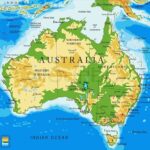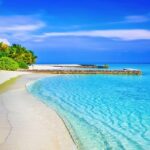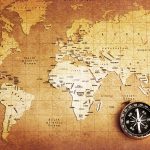
From sun-kissed beaches and ancient rainforests to bustling cities and vast desert landscapes, Australia is a land of contrasts and unforgettable adventures. Whether you’re diving into the Great Barrier Reef, road-tripping along the Great Ocean Road, or sipping world-class wine in the Barossa Valley, the Land Down Under offers something for every kind of traveler. This Australia travel guide will help you navigate the best of the country — where to go, what to see, and how to make the most of your trip to this incredible, diverse continent.
Table of Contents
1. Introduction – Traveling in the Land Down Under
Australia is a vast and diverse country, offering a mix of vibrant cities, unique wildlife, ancient cultures, and breathtaking natural wonders. From the iconic Sydney Opera House to the red sands of the Outback, the Great Barrier Reef to the lush rainforests of Queensland, there’s something here for every kind of traveler. Whether you’re an adventure junkie, a beach bum, a foodie, or a history buff, Australia delivers unforgettable experiences. With friendly locals and a laid-back lifestyle, it’s a place where you can feel both the thrill of exploration and the comfort of home.
2. Weather
Australia’s climate varies significantly due to its size:
- Summer (Dec–Feb): Hot and dry in most regions. Northern areas like Darwin and Cairns can be tropical and humid, with a wet season. Southern cities like Melbourne and Sydney enjoy sunny, beach-perfect weather.
- Autumn (Mar–May): Mild and comfortable, great for exploring cities and the countryside.
- Winter (Jun–Aug): Cold in the south (snow in the mountains!), while northern regions remain warm and dry.
- Spring (Sep–Nov): Pleasant temperatures and blooming wildflowers, especially in Western Australia.
Pack accordingly and check local conditions for each destination.
3. Currency
The official currency is the Australian Dollar (AUD). Notes come in denominations of $5, $10, $20, $50, and $100, while coins are in 5c, 10c, 20c, 50c, $1, and $2.
Credit cards are widely accepted, and contactless payments (like Apple Pay, Google Pay, etc.) are common. ATMs are easily accessible, and currency exchange services are available at airports, banks, and major cities.
4. Best Time to Visit
The ideal time to visit depends on where you’re going and what you want to do:
- September to November (Spring) and March to May (Autumn) are generally the best times for most destinations. These shoulder seasons offer mild temperatures, fewer crowds, and beautiful scenery.
- December to February is perfect for hitting the beaches, exploring the southern cities, and enjoying summer festivals.
- June to August is great for skiing in the Snowy Mountains or visiting the tropical north, which has dry and sunny weather during this time.
5. Getting There
Arriving by Air
Australia is geographically isolated, so the most common and convenient way to get there is by air. Despite the long travel time for many international visitors, the journey is made more comfortable with numerous well-connected airports and high-quality international airlines.
Major International Gateways
Australia has several major international airports, with excellent facilities and connections:
- Sydney Kingsford Smith International Airport (SYD): The busiest and most popular entry point, with direct flights from North America, Asia, Europe, and the Middle East.
- Melbourne Airport (MEL): A major hub in southeastern Australia, well-connected to Asia and the Pacific.
- Brisbane Airport (BNE): Ideal for those heading to the Great Barrier Reef or the Gold Coast.
- Perth Airport (PER): Located in Western Australia, this is the main access point for travelers coming from Africa, India, and the Middle East.
- Adelaide Airport (ADL): Smaller but growing in international traffic; a great starting point for exploring South Australia and its wine regions.
Direct Flights
You can find direct international flights to Australia from:
- North America: Los Angeles, San Francisco, Vancouver, Dallas, Honolulu
- Europe: London (non-stop to Perth), with many more routes via stopovers
- Asia: Singapore, Tokyo, Bangkok, Hong Kong, Kuala Lumpur, Seoul, and more
- Middle East: Dubai, Abu Dhabi, Doha
- New Zealand & the South Pacific: Multiple daily flights from Auckland, Wellington, Christchurch, and Fiji
Flight durations can range from:
- USA West Coast to Sydney: ~14–15 hours
- London to Perth (non-stop): ~17 hours
- Singapore to Sydney: ~8 hours
Entry Requirements & Visas
Most travelers will need a visa before entering Australia. The type of visa you require depends on your nationality and travel purpose:
- Electronic Travel Authority (ETA) – Subclass 601: Available for passport holders from countries like the USA, Canada, Japan, and South Korea. It allows for tourism or business visits of up to 3 months at a time.
- eVisitor visa – Subclass 651: Free visa for EU and a few other European countries, valid for multiple visits within a 12-month period.
- Visitor visa – Subclass 600: For travelers who are not eligible for ETA or eVisitor or those planning longer stays.
You can apply online through the official Australian Government Department of Home Affairs website.
Arrival Tips
- Biosecurity is strict. Be sure to declare all food, plant materials, and animal products. Even items like wooden souvenirs or hiking boots with dirt can cause issues.
- Customs process can take time at major airports, especially during peak travel seasons, so allow ample time for connections or onward travel.
- Domestic connections: Australia is a large country, so flying between cities is common. Major domestic airlines include Qantas, Virgin Australia, Jetstar (low-cost), and Rex Airlines.
6. Top Cities To Visit In Australia
Sydney, New South Wales

Why Visit: Australia’s most iconic and cosmopolitan city, known for its stunning harbour, famous landmarks, and golden beaches.
Top Attractions:
- Sydney Opera House: Architectural marvel and cultural hub. Book a tour or see a live performance.
- Sydney Harbour Bridge: Climb it for unforgettable panoramic views.
- Bondi Beach: Surf, swim, or walk the Bondi to Coogee coastal trail.
- The Rocks: Historic area with cobblestone streets, pubs, and weekend markets.
- Royal Botanic Garden: Peaceful escape with harbor views, right in the heart of the city.
Travel Tips:
- Use the Opal Card for easy public transport across trains, buses, and ferries.
- Take the ferry to Manly for a scenic ride and a day at the beach.
- Visit during Vivid Sydney (May–June) for an epic light and art festival.
Melbourne, Victoria

Why Visit: Australia’s cultural and coffee capital, known for its arts, food scene, and European-style laneways.
Top Attractions:
- Federation Square: A modern gathering spot with museums and art galleries.
- Laneways & Street Art: Explore Hosier Lane, Degraves Street, and AC/DC Lane.
- Queen Victoria Market: A historic market offering fresh produce, food stalls, and souvenirs.
- St Kilda: Chill by the beach, walk the pier, and spot little penguins at dusk.
- Great Ocean Road (day trip): A scenic coastal drive to the 12 Apostles.
Travel Tips:
- Trams in the CBD are free—perfect for getting around the city core.
- Known for four seasons in a day—pack layers.
- Visit during Australian Open (January) or the Melbourne International Comedy Festival (March–April).
Brisbane, Queensland

Why Visit: A sunny, riverfront city with a laid-back vibe, gateway to the Gold Coast and Great Barrier Reef.
Top Attractions:
- South Bank Parklands: Great for swimming (at Streets Beach), dining, and culture (Queensland Museum, QAGOMA).
- Lone Pine Koala Sanctuary: Cuddle a koala and feed kangaroos.
- Story Bridge Adventure Climb: For adrenaline and views of the city skyline.
- New Farm & Powerhouse: Hip riverside district with live performances and weekend markets.
- Mt Coot-tha Lookout: Panoramic city views and great bushwalks.
Travel Tips:
- Enjoy a CityCat ferry ride on the Brisbane River.
- Use Brisbane as a base for trips to Moreton Island or the Sunshine Coast.
- Subtropical climate—visit in winter (June–August) for sunny, mild days.
Perth, Western Australia

Why Visit: Australia’s sunniest capital city, known for its relaxed vibe, beautiful beaches, and proximity to natural wonders.
Top Attractions:
- Kings Park and Botanic Garden: One of the world’s largest city parks with skyline views.
- Cottesloe Beach: Perfect for swimming, sunsets, and snorkeling.
- Fremantle: Historic port city with markets, pubs, and maritime history.
- Rottnest Island: Day trip paradise with turquoise beaches and friendly quokkas.
- Elizabeth Quay & Perth Zoo: Great for families and riverside walks.
Travel Tips:
- Public transport includes ferries, buses, and trains, and there are free CAT buses in the CBD.
- Great base for wine lovers—Swan Valley is just 30 minutes away.
- Spring (Sept–Nov) is ideal for wildflower season.
Adelaide, South Australia

Why Visit: A charming city with a strong arts scene, wine country on its doorstep, and plenty of festivals.
Top Attractions:
- Adelaide Central Market: A foodie haven with local produce and multicultural cuisine.
- Glenelg Beach: Easy tram ride from the city—great for swimming and dining.
- Art Gallery of South Australia & Museum: Well-curated collections in the cultural precinct.
- Barossa Valley & McLaren Vale: World-famous wine regions only an hour away.
- Adelaide Oval: Catch a cricket match or tour this iconic sports venue.
Travel Tips:
- Known as the “Festival City”—visit during Adelaide Fringe (Feb–Mar) or WOMADelaide.
- The city is flat and compact—perfect for cycling.
- Spring and autumn offer ideal weather for exploring.
Hobart, Tasmania

Why Visit: A blend of heritage charm and wilderness, offering access to Tasmania’s untouched landscapes.
Top Attractions:
- MONA (Museum of Old and New Art): Bold, bizarre, and brilliant.
- Salamanca Market: Held every Saturday, full of local crafts, food, and art.
- Mt Wellington: Drive or hike up for sweeping views of Hobart and beyond.
- Battery Point: Quaint, historic neighborhood with colonial architecture.
- Bruny Island: A foodie’s paradise with scenery, cheese, oysters, and wildlife.
Travel Tips:
- Hobart is a great base for exploring Tasmanian national parks (e.g., Freycinet, Mt Field).
- Cooler climate year-round—pack a warm layer, even in summer.
- Rental cars are recommended for exploring beyond the city.
Cairns, Queensland

Why Visit: Gateway to the Great Barrier Reef and the Daintree Rainforest—perfect for nature lovers and adventure seekers.
Top Attractions:
- Great Barrier Reef: Snorkel or dive at one of the world’s most famous natural wonders.
- Kuranda Scenic Railway & Skyrail: Scenic ride through tropical rainforest to a charming mountain village.
- Cairns Esplanade Lagoon: Free public swimming pool on the waterfront.
- Daintree Rainforest: Take a guided tour or river cruise in this ancient jungle.
- Atherton Tablelands: Explore waterfalls, crater lakes, and local produce.
Travel Tips:
- No beaches in the city itself—visit Palm Cove or Port Douglas nearby.
- Best to visit during the dry season (May–October) to avoid tropical rains and jellyfish.
- Many tours depart from Cairns—book in advance, especially during peak season.
7. Best Places To Visit In Australia
Great Barrier Reef, Queensland

Why Visit: The world’s largest coral reef system, stretching over 2,300 km along the Queensland coast. It’s one of the Seven Natural Wonders of the World and a UNESCO World Heritage Site.
Top Experiences:
- Snorkeling or Scuba Diving: From Cairns or Port Douglas, dive into vibrant coral gardens teeming with marine life.
- Glass-bottom Boat or Helicopter Tours: Ideal for non-swimmers or those wanting aerial views of the reef.
- Fitzroy & Green Islands: Beautiful coral cays for day trips.
- Liveaboard Diving Trips: Multi-day diving expeditions to remote reef locations.
Travel Tips:
- Best visited from Cairns, Port Douglas, or Airlie Beach (Whitsundays).
- Visit between June and October for ideal weather and visibility.
- Wear stinger suits in summer due to jellyfish season.
Uluru-Kata Tjuta National Park, Northern Territory

Why Visit: Uluru (Ayers Rock) is a sacred monolith at the heart of Australia’s Red Centre—deeply significant to the Anangu people and a spiritual place of awe.
Top Experiences:
- Uluru Base Walk: A 10.6 km flat trail that circles the base, with interpretive signs and cultural insights.
- Field of Light: Bruce Munro’s stunning solar-powered art installation illuminates the desert at night.
- Sunrise/Sunset Viewing: Watch Uluru change colors with the light—absolutely magical.
- Kata Tjuta (The Olgas): Nearby rock domes with beautiful hiking trails like the Valley of the Winds.
Travel Tips:
- Fly into Yulara Airport (Ayers Rock Airport) with connections from major cities.
- Respect the site’s cultural significance—climbing Uluru is not permitted.
- Visit between May and September to avoid the desert heat.
Great Ocean Road, Victoria

Why Visit: One of the world’s most scenic coastal drives, famous for its dramatic cliffs, limestone stacks, and charming seaside towns.
Top Stops:
- 12 Apostles: Iconic rock formations rising from the sea—best viewed at sunset.
- Loch Ard Gorge & London Arch: Other striking coastal landmarks.
- Lorne & Apollo Bay: Relaxed beach towns ideal for overnight stays.
- Otway Rainforest: Lush forest walks and waterfalls.
- Bells Beach: Famed surf spot near Torquay.
Travel Tips:
- Self-drive gives flexibility, but day tours are available from Melbourne.
- Allow 2–3 days to explore fully.
- The road can be winding—drive cautiously, especially in wet weather.
Whitsunday Islands, Queensland

Why Visit: A tropical paradise of 74 islands nestled between the mainland and the Great Barrier Reef. Known for white sand beaches and turquoise waters.
Top Experiences:
- Whitehaven Beach: Regularly voted one of the world’s best beaches—famous for its pure silica sand.
- Sailing Tours: Multi-day yacht cruises are the best way to explore multiple islands.
- Scenic Flights: Fly over Heart Reef and the reef system for jaw-dropping views.
- Snorkeling & Diving: Coral gardens and marine life in the fringing reefs.
Travel Tips:
- Best accessed from Airlie Beach or Hamilton Island Airport.
- Dry season (May–October) offers perfect weather and calm seas.
- Luxury resorts and eco-lodges available on Hamilton, Daydream, and Hayman Islands.
Tasmania

Why Visit: A wild, rugged island state with pristine wilderness, gourmet food, and rich convict history.
Top Destinations:
- Freycinet National Park: Hike to Wineglass Bay for postcard-perfect views.
- Cradle Mountain: Explore alpine landscapes and wildlife in this iconic national park.
- Hobart & MONA: Tasmania’s capital offers historic charm and cutting-edge art.
- Bruny Island: For cheese, oysters, and untouched coastal scenery.
- Port Arthur Historic Site: A hauntingly beautiful former penal settlement.
Travel Tips:
- Rent a car for a road trip—distances are manageable and scenery is stunning.
- Weather can change rapidly—layered clothing is essential.
- Best time to visit: December–March (Tasmanian summer).
Blue Mountains, New South Wales

Why Visit: Just a short drive from Sydney, this World Heritage-listed area is known for dramatic cliffs, eucalyptus forests, waterfalls, and cozy mountain villages.
Top Attractions:
- Three Sisters Rock Formation: Iconic viewpoint at Echo Point.
- Scenic World: Ride the Skyway, Cableway, and the world’s steepest railway.
- Wentworth Falls & Leura Cascades: Stunning hikes and lookouts.
- Jenolan Caves: One of the world’s oldest and most spectacular cave systems.
Travel Tips:
- Best visited as a day trip or weekend escape from Sydney.
- Cool climate—bring warm clothes, even in summer.
- Avoid foggy mornings if you’re going for views.
Daintree Rainforest & Cape Tribulation, Queensland

Why Visit: The oldest tropical rainforest in the world, where the reef meets the rainforest—a biodiversity hotspot unlike anywhere else.
Top Experiences:
- Jungle Boardwalks: Stroll through lush forest with exotic plants and wildlife.
- Daintree River Cruise: Spot saltwater crocodiles and birdlife.
- Cape Tribulation Beach: Wild and beautiful, where rainforest meets the sea.
- Guided Aboriginal Tours: Learn about the Kuku Yalanji people’s deep connection to the land.
Travel Tips:
- 2–3 hour drive north of Cairns—4WD recommended beyond Cape Tribulation.
- Very humid—visit in the dry season (May–October).
- Limited reception and facilities—book accommodations ahead.
Kakadu National Park, Northern Territory

Why Visit: A UNESCO World Heritage Site that combines natural beauty with rich Indigenous culture, rock art, and wildlife.
Top Attractions:
- Ubirr & Nourlangie Rock Art Sites: 20,000-year-old Aboriginal rock paintings.
- Yellow Water Billabong: Boat cruises to see crocodiles, birds, and water lilies.
- Jim Jim & Twin Falls: Iconic waterfalls in the heart of the park.
- Cultural Centers: Learn about Bininj/Mungguy traditions.
Travel Tips:
- Best accessed via Darwin (3–4 hours drive).
- Visit in the dry season (May–October) when roads are open.
- National Park pass required; 4WD needed for many sites.






